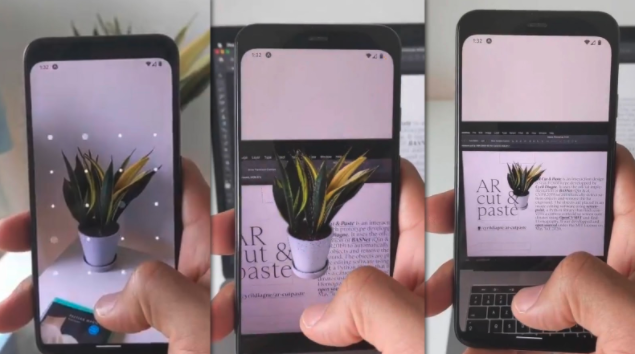
Augmented Reality (AR) has been developing technology for quite some time and this means that more AR content is going to be coming out at an accelerated rate.
The earliest functional AR systems that provided immersive mixed reality experiences for users were invented in the early 1990s, starting with the Virtual Fixtures system developed at the U.S. Air Force’s Armstrong Laboratory in 1992.
Adobe Flash had AR capabilities, although then it was more of a gimmick, lacking the foundation to present a commercial interest.
But following increased investment which produced greater hardware capabilities, a more fearless investment approach from brands, and healthy competition from VR, it seems AR is on the cusp of massive growth.
Despite this, AR as a medium still has some way to go before its design standards can be truly polished.
Design, through all its mediums, has seen principles, methods and practice evolve over the past century.
But many legendary designers’ most important principles, from layout and graphic design to branding and animation, can quickly unravel when introduced to a new setting with dynamic environments and an unclear context.
Video games and web design came up against this exact problem in their infancy.
AR is no different.
People are prone to use interactive content in ways the designer never intended it to be used, and with AR, every experience differs from one another.
Devices differ in resolution, hardware, and software capabilities.
This presents a number of challenges to overcome.
Just when it would seem standardisation across the web is harmonising, AR and VR start to conjure up the chaos again.
Value in Research
One of the winners in terms of R&D is Facebook.
They have an unlimited resource of enthusiastic users creating content for Instagram at no extra cost.
The social media giant is constantly putting new AR content out.
A similar strategy is used by the legendary games company Valve, who provides the end-user with the tools to make the content they consume.
Overcoming limitations with AR content
3D software and game engines are building features for AR.
Cinema 4D, Unity, Unreal, and Blender are all looking to provide tools for content creators.
Creating high-end 3D assets for AR has similarities to producing assets for video games.
The level of craft in video games today is astonishing when compared to its origins.
Game developers were renowned for finding clever and creative methods that worked within the limitations of the time period.
This will be no different when developing AR content.
The limitations should inform designers, developers, and agencies in terms of what to pitch to clients.
Art directing content with technical limitations can prove challenging.
Stylised aesthetics tend to be a safe option when building AR content.
Hardware and software are still insufficient in terms of building out fully polished photo-real content.
R&D is mandatory in order to supply the weaponry, knowledge, and problem-solving skills to overcome any curveballs.
Particularly when every few weeks brings a new update or feature added to tools.
The accessibility of AR is clear compared to its competition.
Everyone who owns a midrange smartphone can use AR, which is an advantage in the testing and design phase.
It’s easy to borrow someone’s phone to test how content renders on several different devices.
Testing in different visual settings provides important feedback.
Screening every scenario is impractical but will help inform crucial design decisions throughout production.
AR content is more than just entertainment
Much of the content we see is purely entertainment, lacking any further substance, but a space exists for AR to operate as a tool.
Healthcare, military, and education settings have deployed AR for practical use and in many ways, the benefits of the practical adoption of AR have been understated.
Offer valuable clients something different
Retail, fashion, and luxury brands could play a large role in pushing creative content while also providing the budgets that allow AR content to be contextually integrated into a brand.
If brands provide enough resources to build bespoke content outside a container built by a global tech company, it lets designers and developers re-write the rules for AR.
This is a difficult challenge, but often Silicon Valley can be leaned on to provide innovation.
It can restrict the field of view if the only tools in use are built by companies with their own intentions of how AR operates.
The value of open-source AR content
Open source technologies can be a platform of unrestricted creativity.
The technologies under the hood of AR are open source.
Open-source software continues to raise the bar of innovation, but lower the bar of entry for anyone who wants to get involved.
This premise only helps accelerate industry growth. Large private tech companies are seeing the value in keeping technologies and tools accessible to everyone for free.
In 2019, Epic games invested $1.2 million dollars into Blender – a free 3D modeling tool once seen as a hobbyist application is now packed with features that compete with the best paid-for CG software.
WebGL, a Javascript API for rendering interactive 2D and 3D graphics within any compatible web browser, is developed by The Khronos Group, a free not for profit organisation.
What the future holds
Understanding the plethora of resources available is eye-opening.
It places an understanding that AR is not just restricted to certain platforms and containers.
Building new architectures for AR allows for integration into any environment.
Looking forward, AR may not exist in the form we see it as today.
As its ubiquity increases, it has the potential to embed seamlessly into everyday life.
Mixed reality is the premise for seamless integration.
Publicly Magic Leap and Microsoft are the big players in mixed reality and AR is the foundation for compositing the virtual with the real.
As the novelty begins to wear off, the appraisal of designing AR content will increase, just like the web did several years ago, it will undergo its own evaluation of design standards.
In the future, AR will be looked upon as an unhinged universal starting point in the emergence of Mixed Reality tech.
The disorganised current habitat of AR is where the creativity and discovery lies.
Go and have fun with it!!!




